Albeit somewhat of an ode to a previous era, Manchester United versus Arsenal still remains one of the most bitter fixtures in English football.
At one point, the game was the peak of Premier League action. Sir Alex Ferguson and Arsene Wenger trying to outwit each other, tunnel spats with Roy Keane and Patrick Vieira and goals galore from some of the greatest players to walk the face of the earth, the fixture was the pinnacle of entertainment and quality.
While this infamous bout may have lost its titanic appeal, bragging rights are still vital for both sets of fans. The two titans of England locked horns once more on Sunday afternoon at Old Trafford, hoping to get one over on their adversaries.
Erik ten Hag’s United had won their previous three matches and were looking for a fourth straight victory, while the Gunners were sitting at the summit of the table walking out onto the carpeted pitch at the Theatre of Dreams, hoping to be victorious for the sixth game running and to maintain their 100 percent record this season – the only Premier League side to do so.
One streak had to come to an end, and it was the visitors who faltered as Man United took all three points with an emphatic 3-1 win.
This article will be a tactical analysis of Sunday’s huge tie. It will be an analysis of the tactics deployed by both managers, as well as looking at what areas the game was won and lost.
Formations and lineups
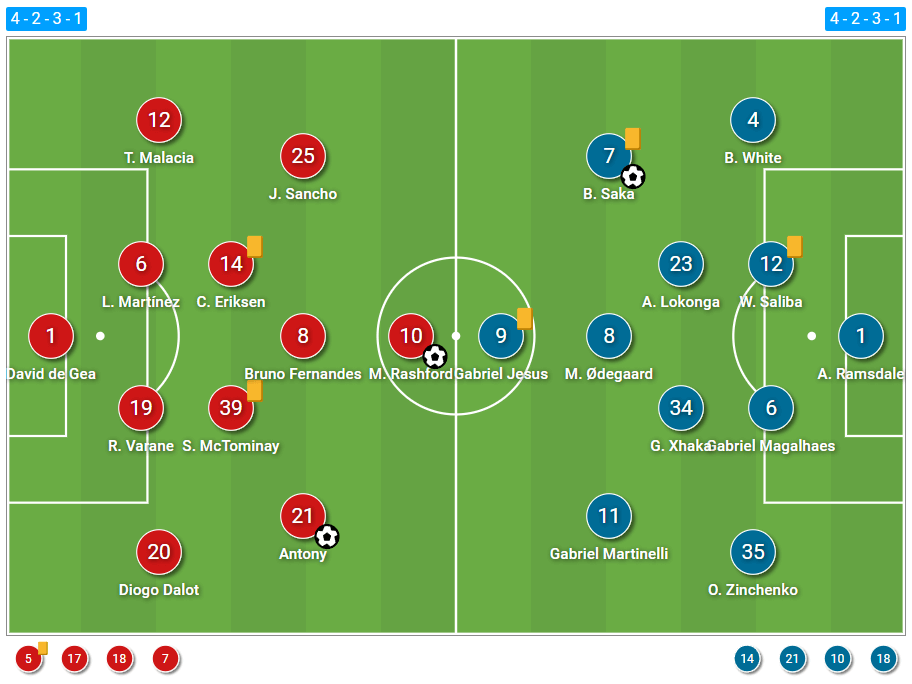
Going into this one, the home boss had picked the same starting eleven for three games in a row, and to great success as well. However, with the signing of Antony from Ajax on deadline day, many pondered whether the Brazilian would be cast straight into the lineup. In fact, he was.
Ten Hag made just one change from the side that put Leicester City to the sword with a 1-0 win on Thursday night, keeping the conventional 4-2-3-1 which he loves so much. Antony came in for Anthony Elanga on the right, while the rest of the lineup was untouched, with both Casemiro and Cristiano Ronaldo being forced to watch on from the bench.
Likewise, with the away team, Mikel Arteta made just one change to the first team from Arsenal’s previous outing against Aston Villa on Wednesday night, once again lining up with a 4-2-3-1. Oleksandr Zinchenko came back into the side, replacing Kieran Tierney.
The two teams and dugouts were filled with quality and the game had the type of atmosphere and edge which would make any neutral salivate at the mouth. It certainly didn’t disappoint either, but how exactly did the result come to fruition?
United’s press and Ramsdale’s distribution
Sunday’s clash was a fabulous showcase in how to set up a high block in relation to the opposition’s build-up structure versus how to beat a press through player quality.
Interestingly, given that the two sides set up in a 4-2-3-1 formation, Manchester United and Arsenal shared similar structures when building out from the back as well as when pressing high.
However, the Red Devils were the team tasked with pressing the most, given that the Gunners boasted 61.29 percent of the ball as well as 42 positional attacks in total. When playing out from Ramsdale, Arsenal used a 4-2 build-up shape, or often a 4-1-1 structure.
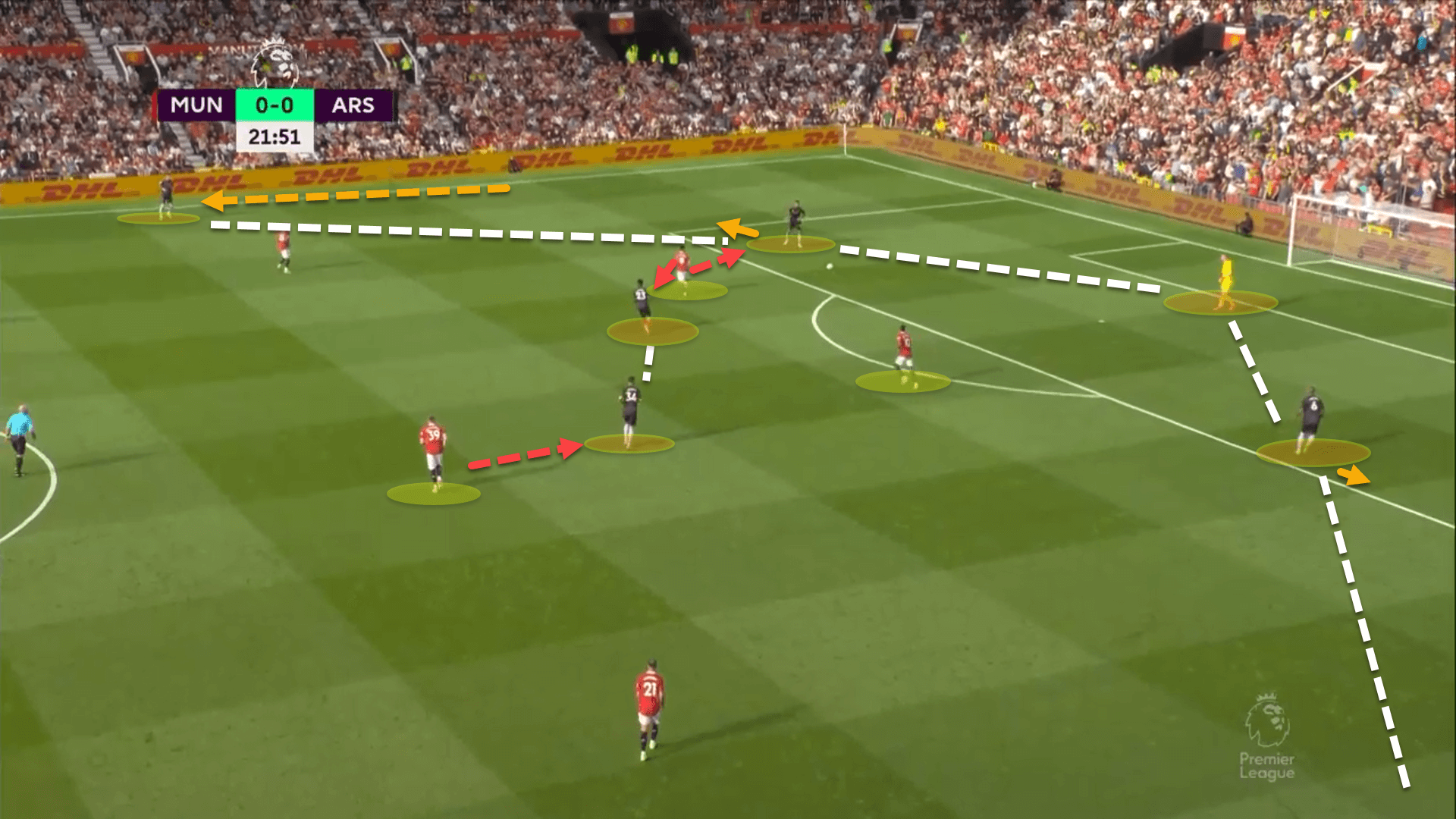
Look here for instance. The two centre-backs have split wide at Ramsdale to allow the keeper to play a little higher between them. Meanwhile, the fullbacks have advanced further slightly but still maintained a decent distance to the central defenders so to receive the ball comfortably.
When Arsenal played out from the back, Albert Sambi Lokonga was the deepest of the double-pivot, with Granit Xhaka moving higher. Ten Hag went man-to-man on the duo with Bruno Fernandes and Scott McTominay. Christian Eriksen sat deeper, protecting the backline.
United’s front three pressed zonally and situationally, and even Fernandes stepped off his man at times to apply pressure to the Arsenal centre-backs alongside Marcus Rashford, as can be seen in the previous image.
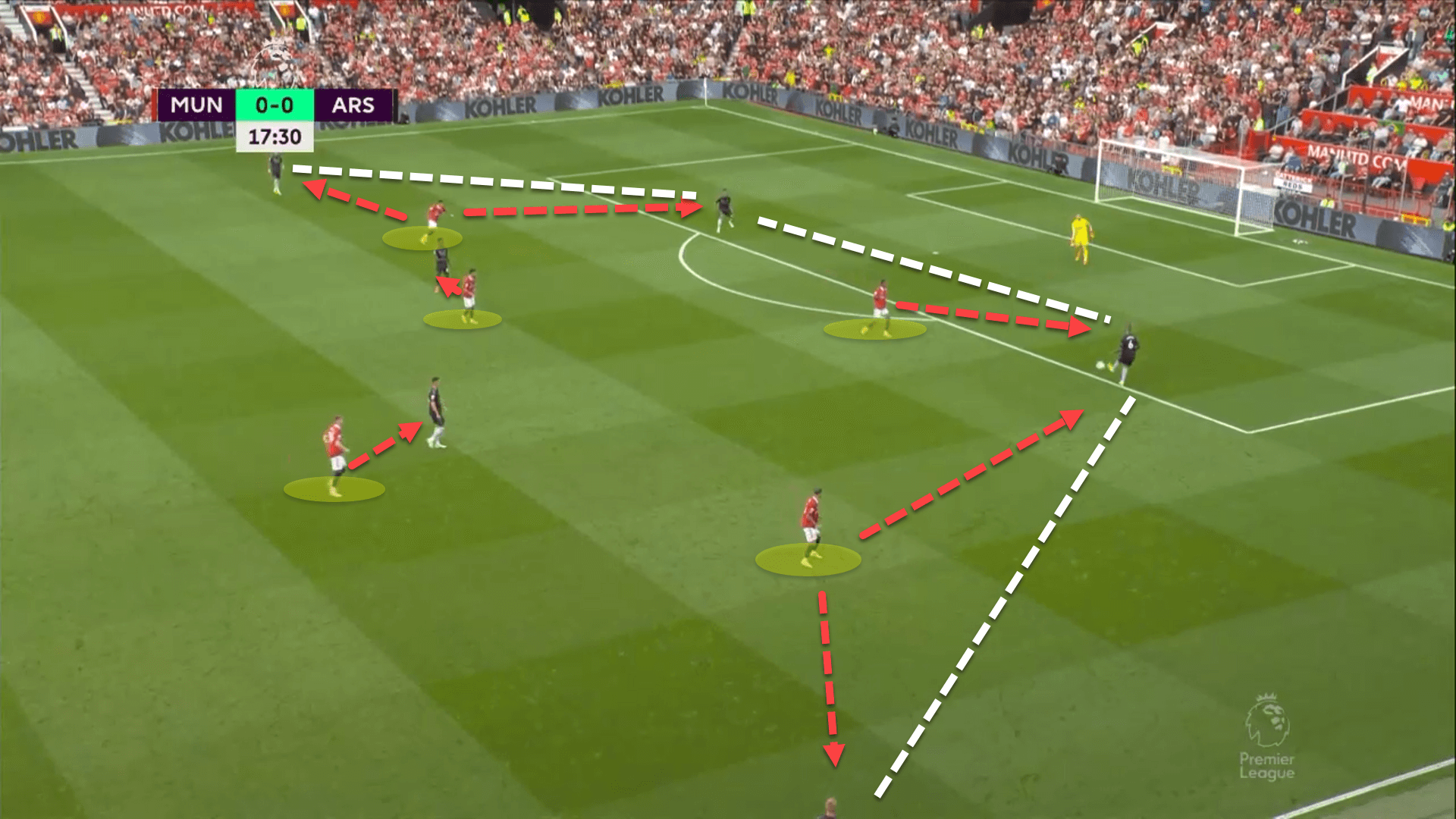
This annotated screenshot perfectly embellishes Manchester United’s pressing structure from the match. Rashford pressed the two centre-backs and goalkeeper, sometimes on his own, other times with the help of Fernandes or one of the wingers depending on the situation.
But it was the role of the wingers which caused the system to break down for United. This wasn’t necessarily the fault of ten Hag or the players but was instead because of the astute game-plan of Arteta and his coaches. Let’s look at why.
Man United’s wingers, Jadon Sancho and goalscorer Antony positioned themselves between the Arsenal fullbacks and centre-backs, which meant they were tasked with covering two players at once.
What Arsenal did so well is lure United’s wingers in centrally by playing lateral passes. This would then leave space for the fullbacks to receive into and so Ramsdale would constantly use this trigger to loft the ball out to both Ben White and Zinchenko to great success.
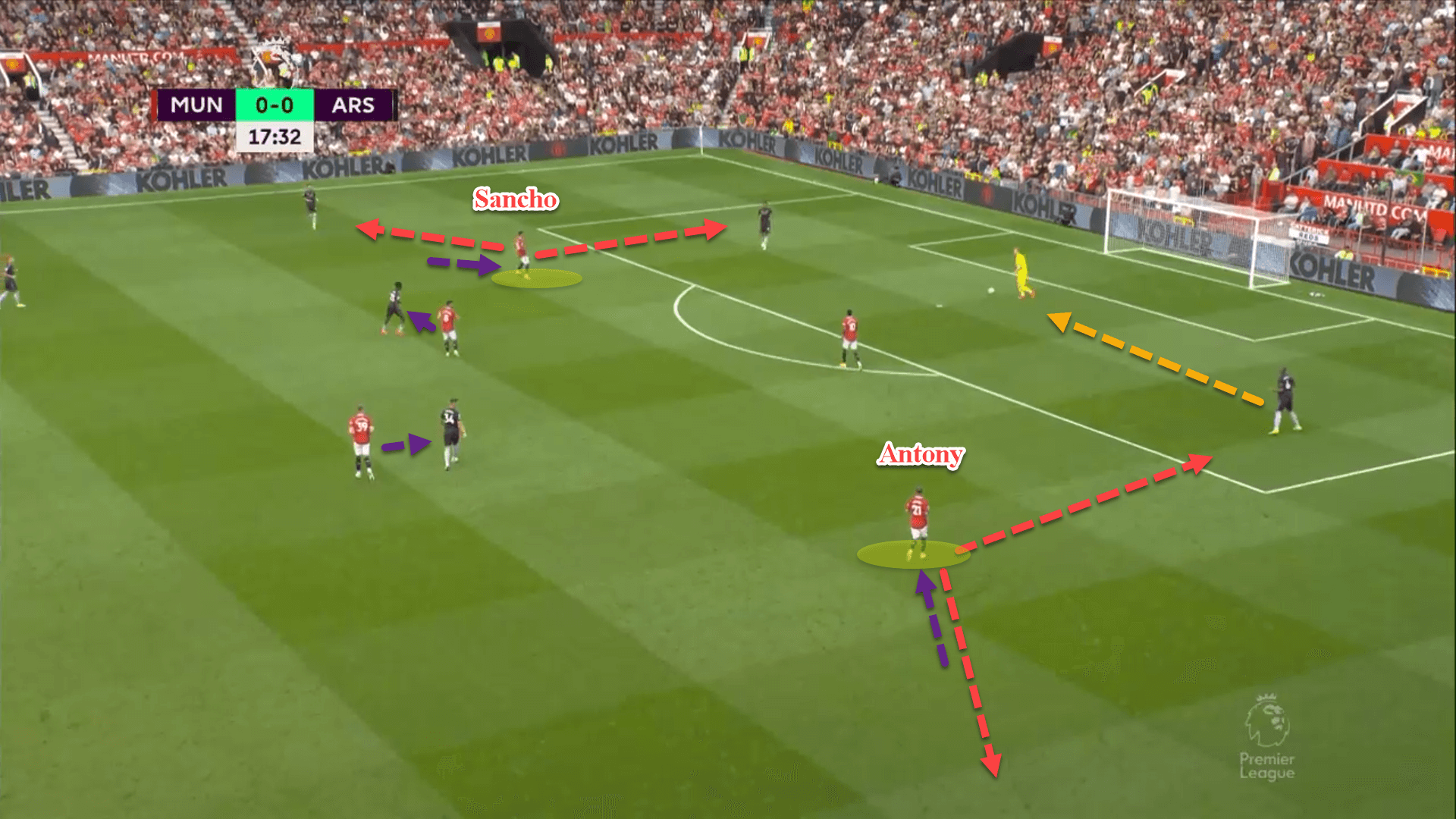
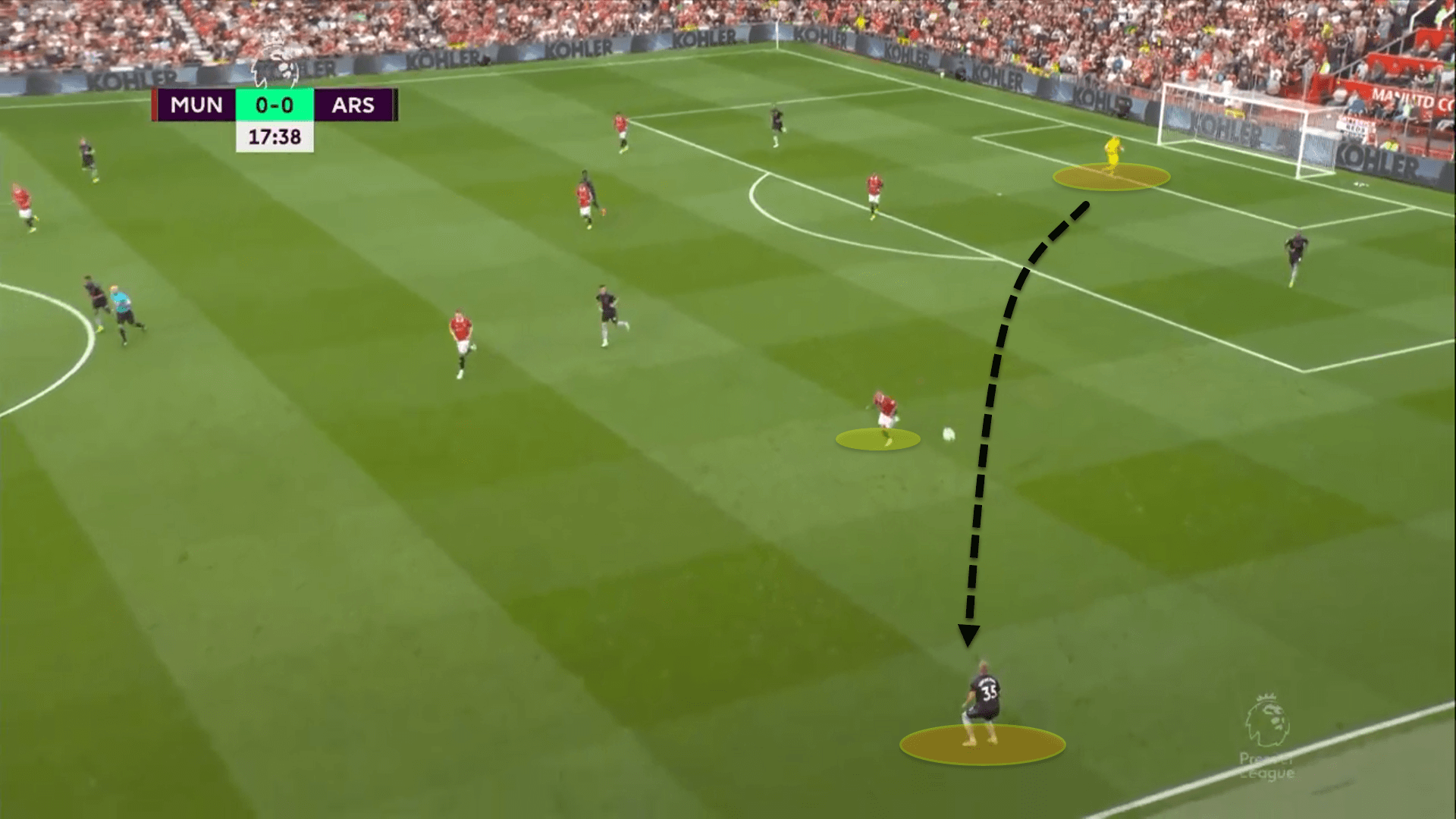
Usually, when situations like this arise, the ball-near defensive fullback will come rushing up the flank to quickly close down their opposite number. United’s fullbacks didn’t move. This was because Arsenal’s wingers were pinning them down.
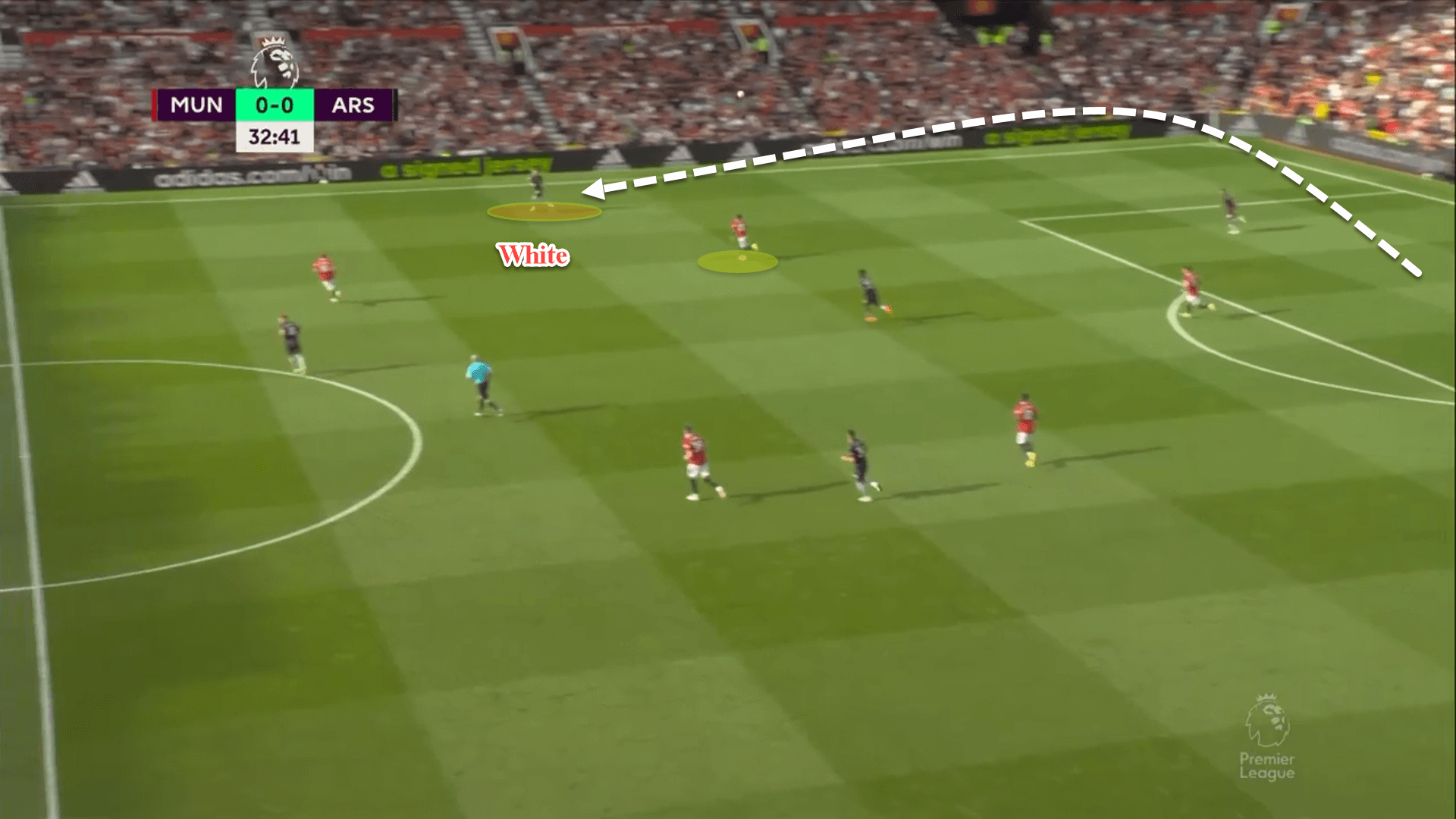
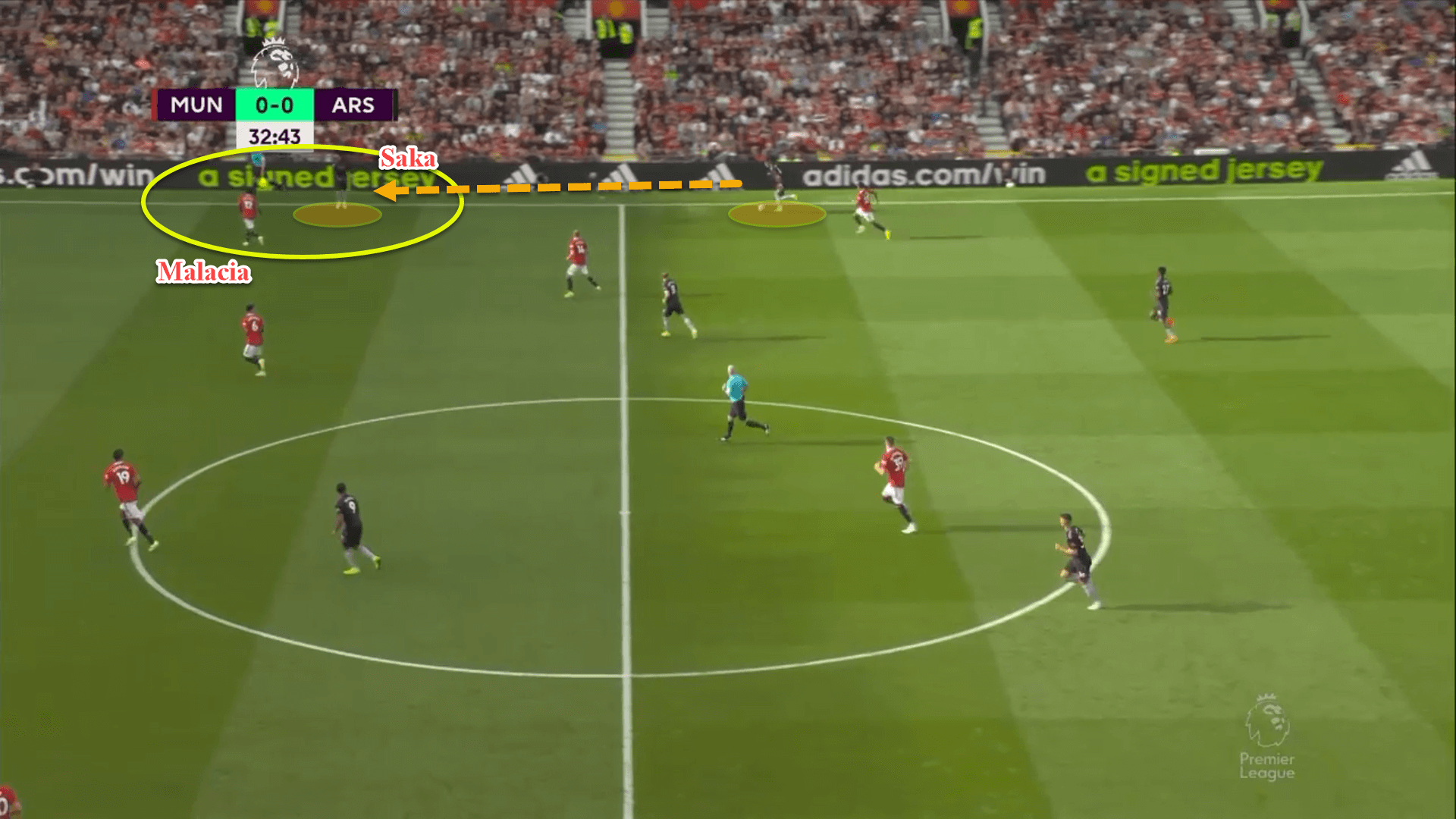
On the flip side, when Arsenal pressed in an identical manner, they were able to be much more successful with their pressing as the fullbacks could step forward since they weren’t being pinned down. This made all the difference.
In the example provided below, White moved up onto Tyrell Malacia and Arsenal managed to put the ball out for a throw-in, stopping any ball progression from the hosts.
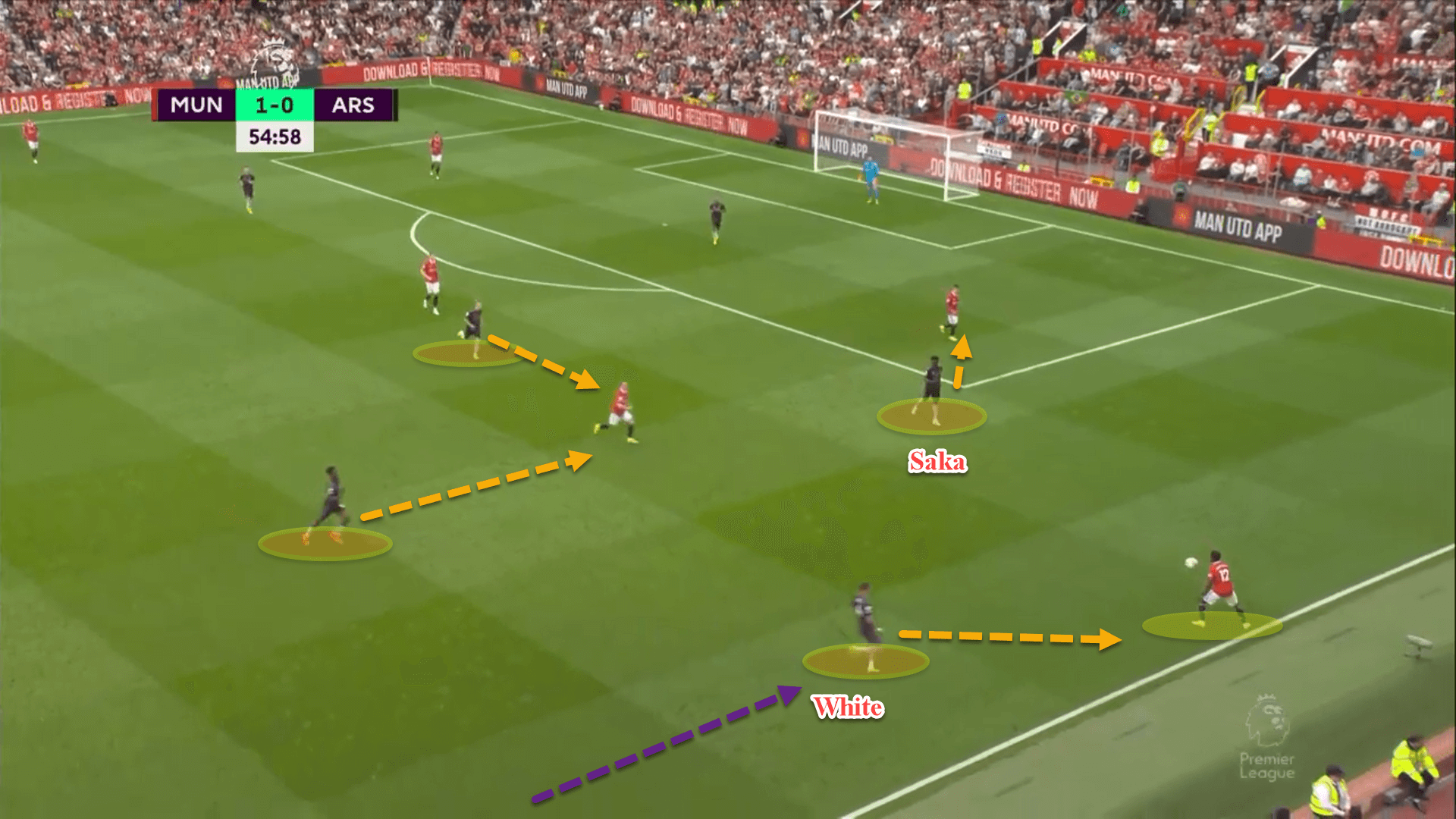
Erik ten Hag managed to get several tactical decisions correct on the day, but his high pressing setup certainly wasn’t one of them, and credit must be handed to Arteta for how the players were positioned, giving them the best chance to play out from deep as possible.
Classic fullback versus winger game
One of the most interesting strategic components of Sunday’s bout was the old-school feeling to the great fixture, created by the battle between the wingers and the fullbacks.
We spoke previously about how Arteta kept his wingers wide on the outside of United’s fullbacks in order to pin them. But when the hosts were defending in a deeper block further down the pitch, having his wide defenders tight to the Arsenal wingers is exactly how ten Hag wanted his side to operate out of possession.
This was risky and could have severely backfired for the Dutch coach, but the 52-year-old imposed full faith in Diogo Dalot and Malacia to win their individual battles against Gabriel Martinelli and Bukayo Saka. Did they repay his faith? Kind of.
Often, when defending against wide players, a manager will instruct the nearest winger to drop back and create a back five. Ten Hag didn’t want to follow this blueprint. The wingers, Sancho and Antony, stayed on Arsenal’s fullbacks, while Dalot and Malacia pushed out to Martinelli and Saka.
However, in doing so, gaps would be left between the fullback and the nearest centre-back. To seal this, the closest defensive midfield player, Eriksen or McTominay, would drop into the backline, creating a temporary back five.
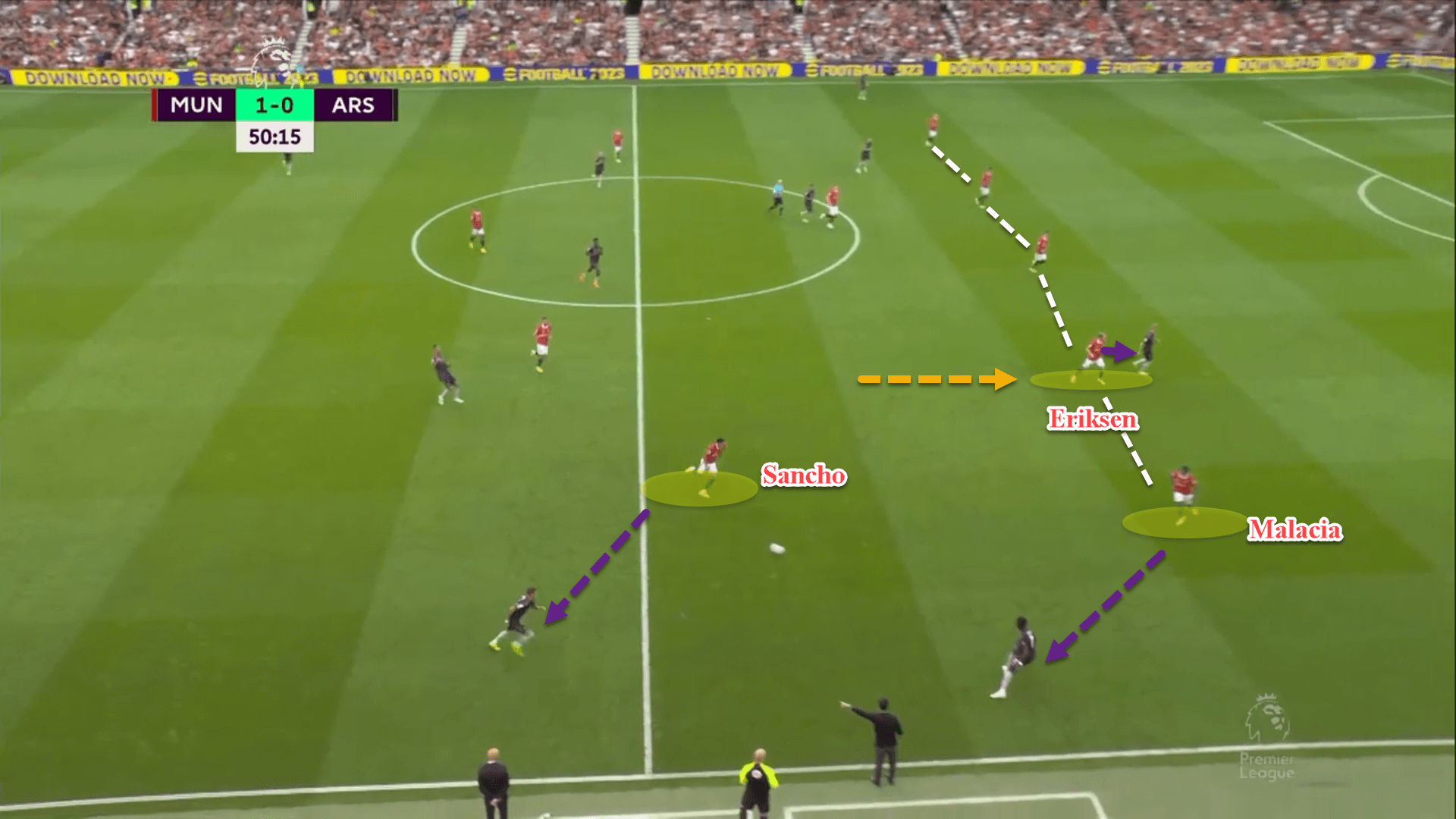
Here, for instance, Eriksen has dropped into the backline to prevent Martin Ødegaard from being able to receive the ball in the space between Malacia and Lisandro Martinez.
The reason ten Hag was keen for his double-pivot to operate in this manner was because Arsenal like to create triangles out wide with the wingers, fullbacks and advanced midfielders.
In possession, Arsenal’s shape switched to a 4-3-3 with Xhaka pushing up into the left halfspace and Ødegaard drifting out to the right while Gabriel Jesus explored the space between the lines. This shape is evident from the side’s pass map:
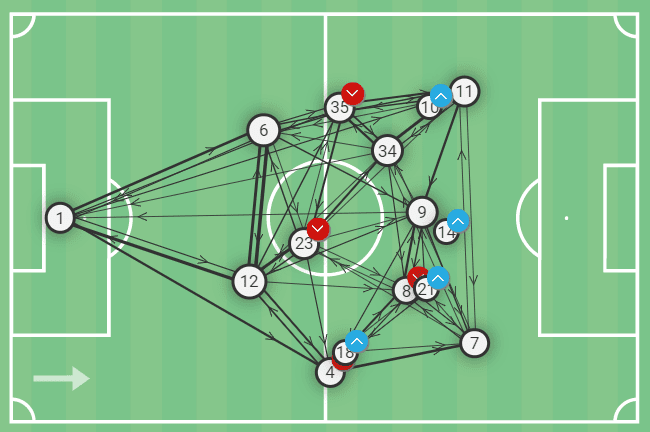
When Arsenal’s wingers received the ball out wide, they had three options. They could either run at the fullback, play the ball inside to the advanced midfielder who was making an underlapping run, or else wait for the overlap from the fullback.
Ten Hag made sure he had all three covered by having the wingers marking Arsenal’s fullbacks, United’s fullbacks on the visitors’ wingers and the double-pivot cutting off the passes into Xhaka and Ødegaard.
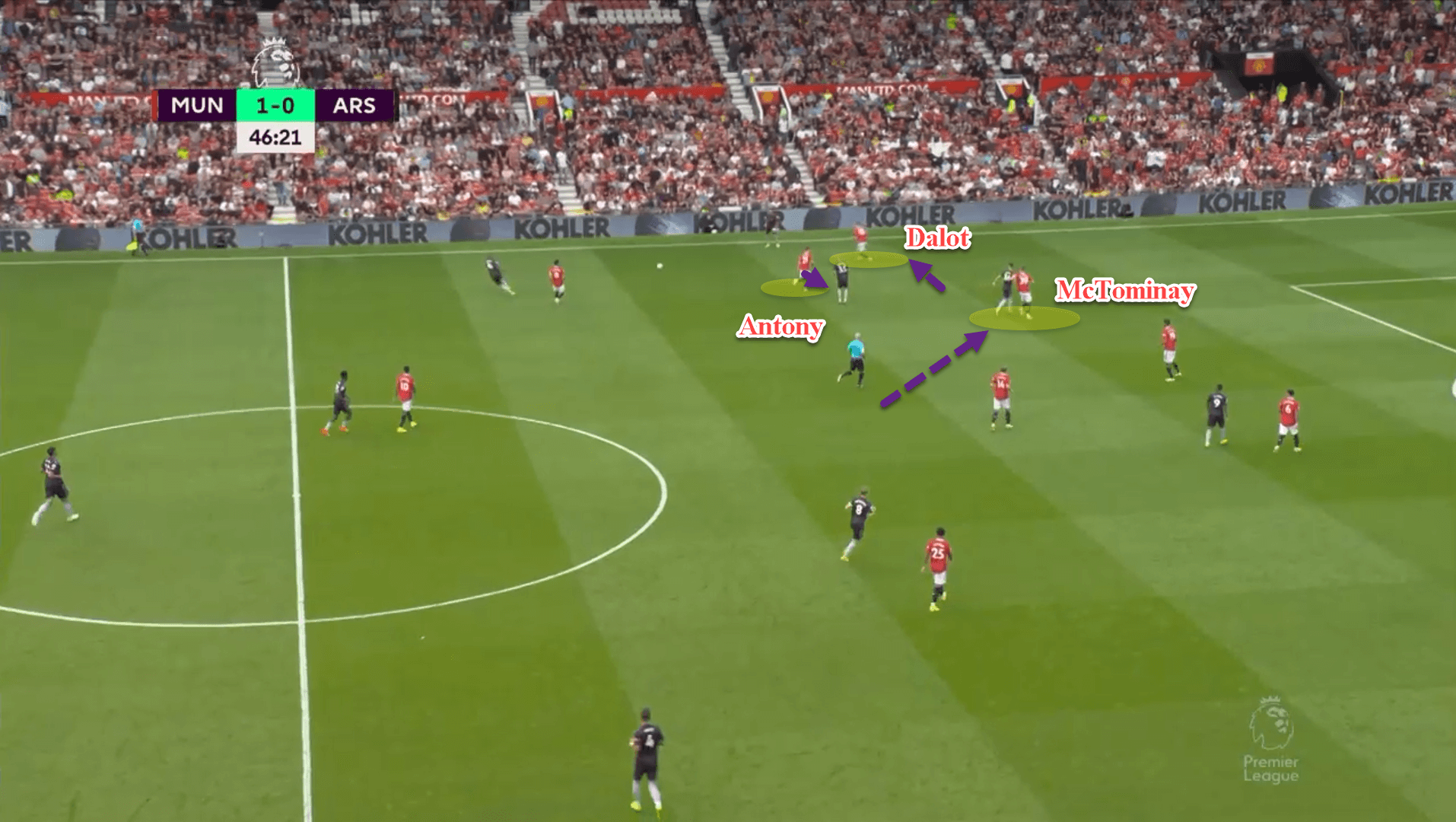
The example above is another scenario where we saw United defending this way in a deeper block, looking to stifle Arsenal’s wide triangles, but on the opposite flank this time.
While this certainly worked in United’s favour, analysing the duels between the wingers and the fullbacks individually, the former won their battles even though the latter won the war.
Diogo Dalot was involved in 12 defensive duels, winning just 2, or 17 percent to be precise, although he did manage to make 12 ball recoveries too. On the opposite side, Malacia competed in 7 defensive duels, and won merely 3, slightly better than Dalot’s record but Saka still bested the Dutch defender overall.
Dalot also had an interesting role when Manchester United were in possession of the ball, which tied into ten Hag’s keenness for his fullbacks to stay tight to the Arsenal wingers.
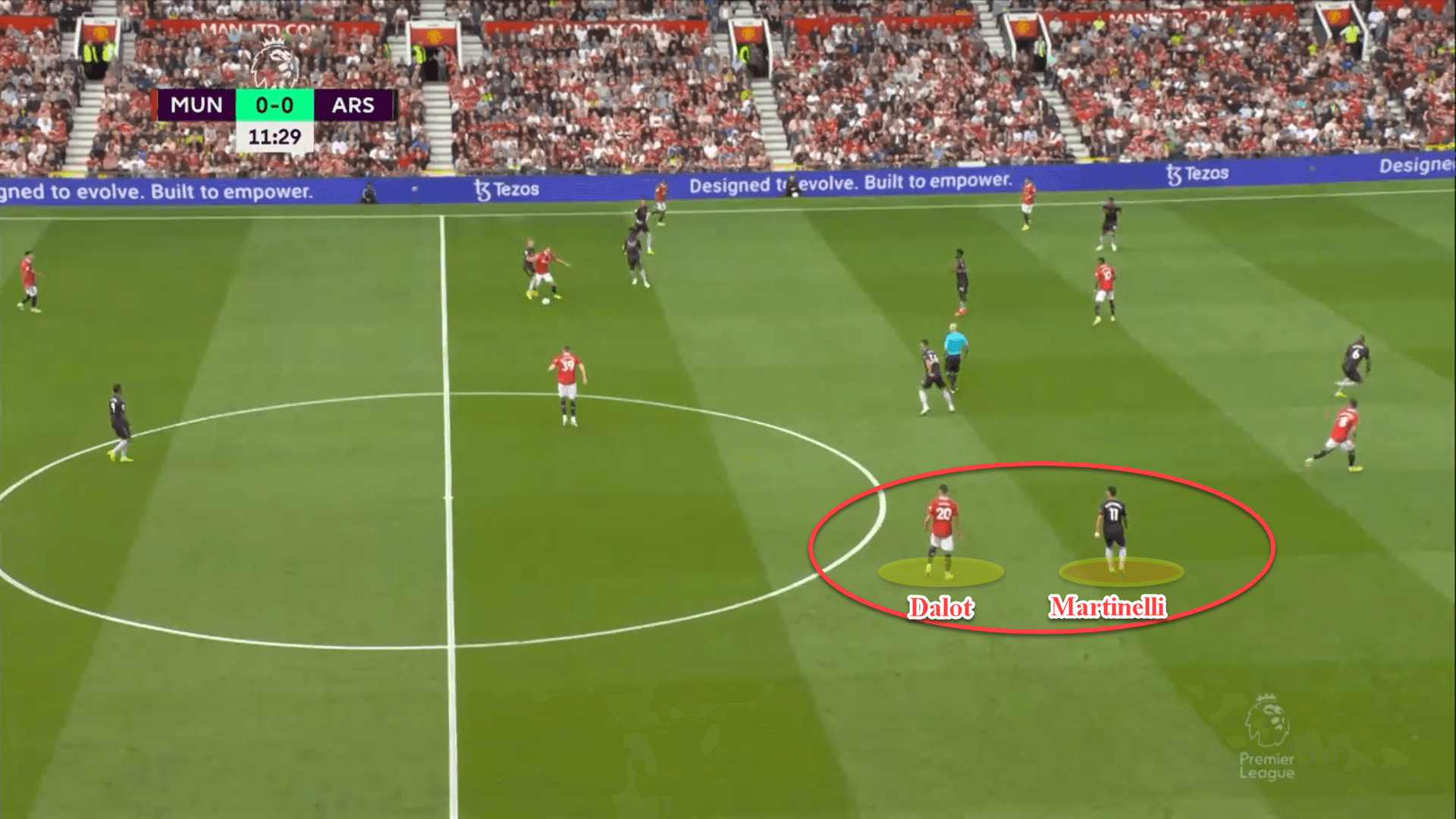
As shown from the image above, when United were in a rare, settled positional attack, Antony would stay wide and hug the touchline, keeping the width on the right. Dalot would remain tucked inside. The reason for this was because, firstly, Antony is deadly when coming inside on his left foot from the touchline, and secondly, Dalot could man-mark Martinelli.
This is practically rest-defence but more individualistic. Dalot would stay very close to the rapid Brazilian winger in case Arsenal won the ball and looked to hit United on the break. Unfortunately, it didn’t quite work as Martinelli was just too fast for the Portuguese international.
In fact, this is exactly how Arsenal opened the scoring at Old Trafford before VAR ruled out Martinelli’s goal.
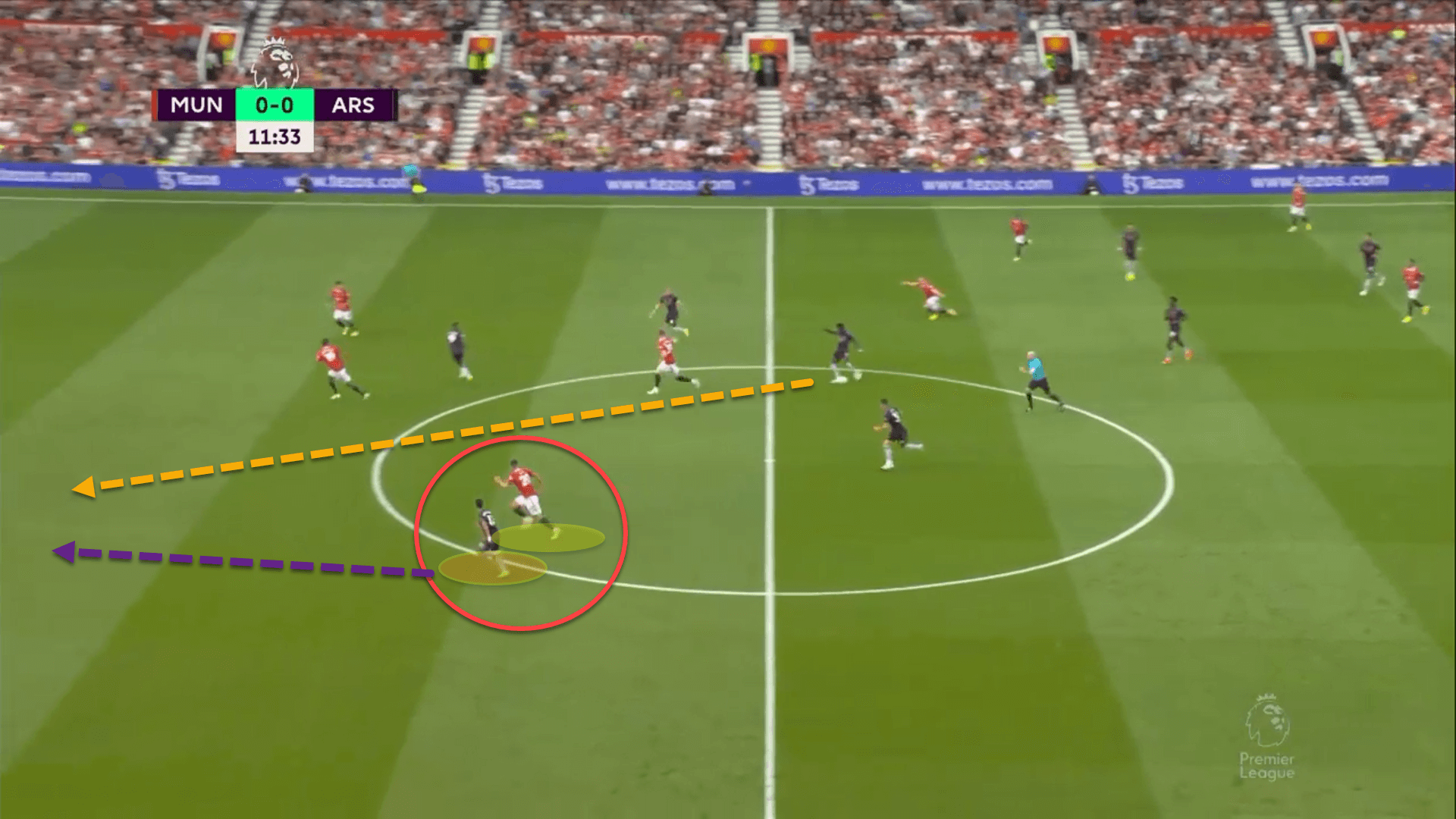
Dalot was sitting tightly on Martinelli despite United having possession of the ball. The Gunners regained possession, and the former Ituano starlet darted in behind the home side’s backline.
United’s right-back tried to stay with Martinelli during the transition but couldn’t get near him before the winger tucked it past David de Gea at the far post. It would have been a truly great transition-based goal had Eriksen not been fouled in the build-up by Ødegaard.
Space between the lines and United’s transitions
One of the most basic principles of block defending is keeping compact between the lines and cutting off central passing lanes. Particularly in the first half, Arsenal’s lack of compactness was evident and caused severe problems for the Gunners.
As spoken about earlier, Arsenal pressed in a similar manner to United. Odegaard would often sit on Man United’s deepest midfield pivot but also stepped up to press the home backline alongside Jesus. When this happened, the Gunners switched from a 4-2-3-1 to a 4-4-2.
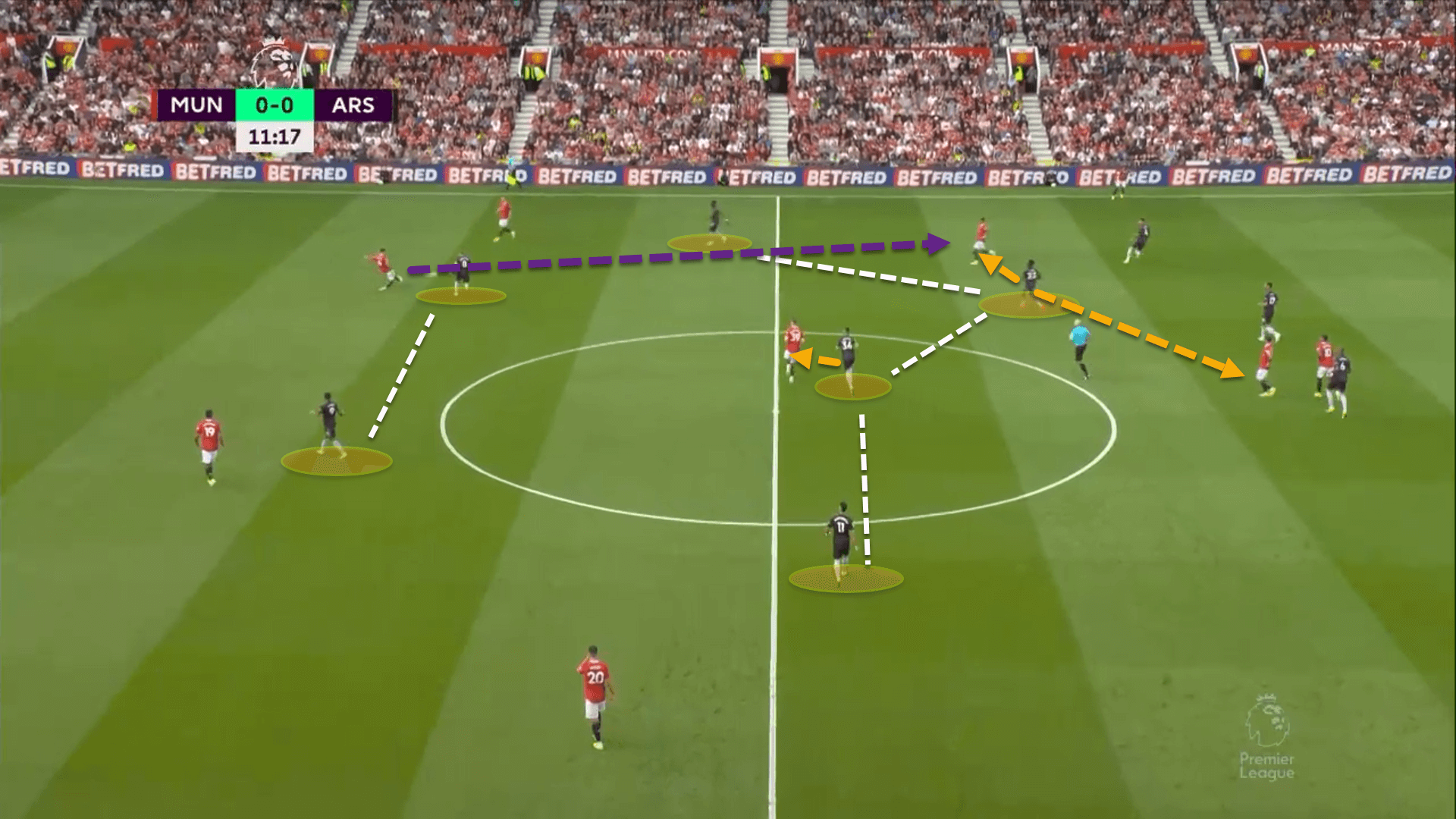
However, the defensive block was far too disorganised and the gaps between the forward line, midfield and defence were completely uneven, and Arsenal were typically overloaded in the middle.
For example, as portrayed in the previous image, Lokonga was forced to defend two players at once while Xhaka sat on McTominay once Odegaard stepped up, which allowed for easy ball progression for the Red Devils.
This exact situation led to the opening goal of the game. Eriksen dropped deep to receive behind Arsenal’s two-man first line of pressure. Lokonga quickly stepped out to close him down, while Xhaka was man-marking McTominay. This left Fernandes free between the lines to call for a pass.
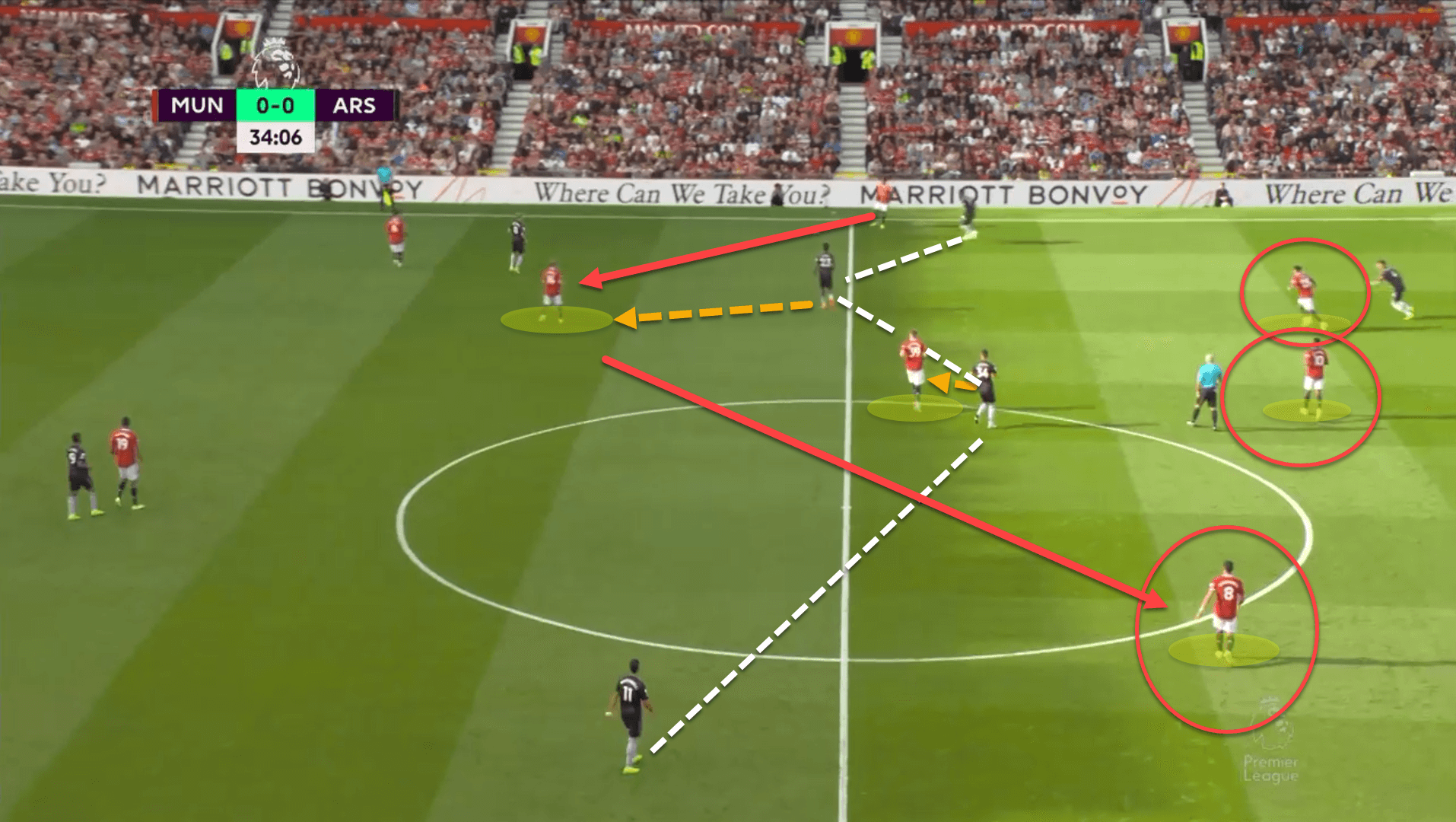
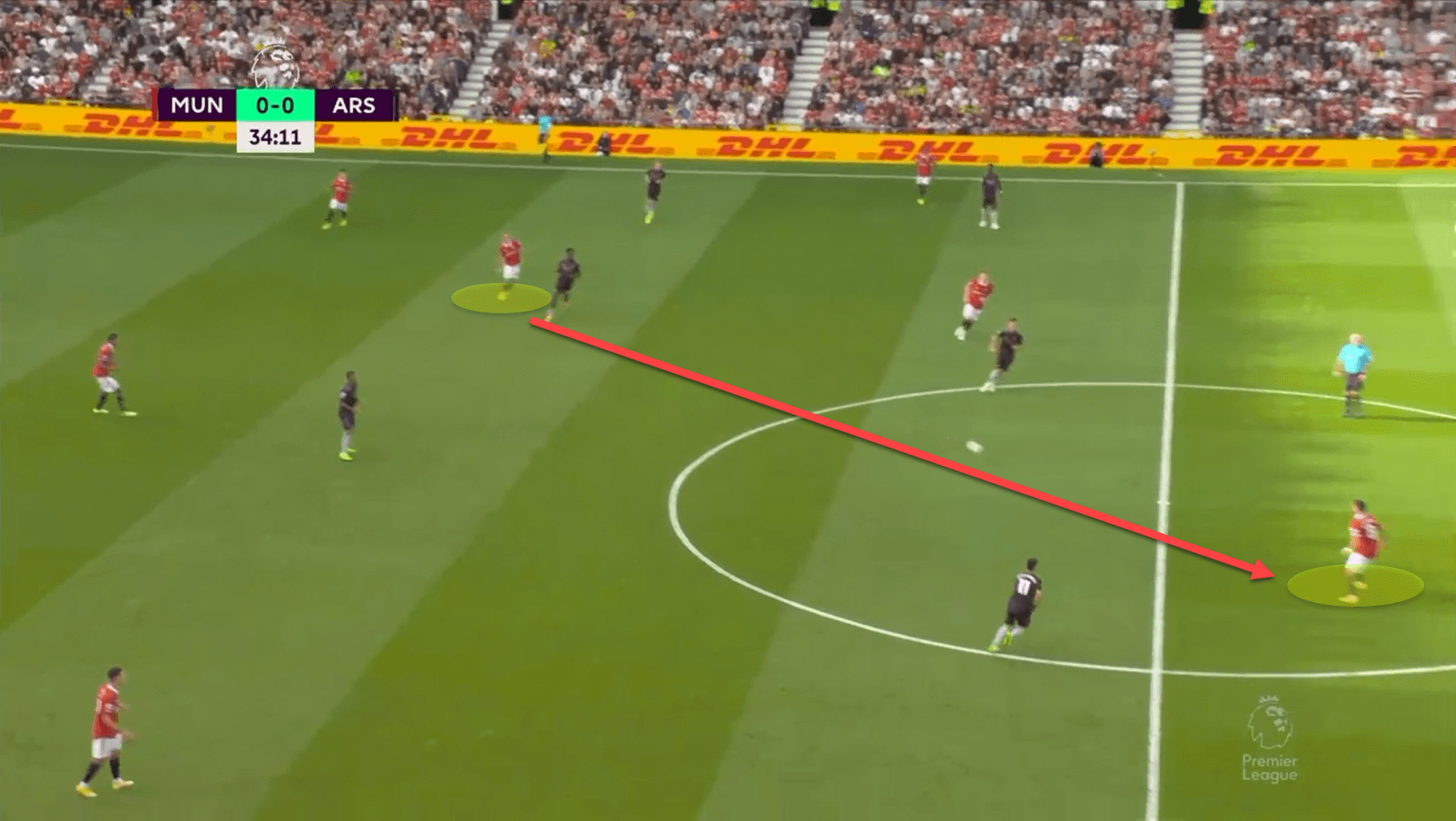
The Portuguese star received the ball from a sumptuous pass by Eriksen to break Arsenal’s first two defensive lines, and after some rapid attacking play, the ball fell to Antony for his debut goal.
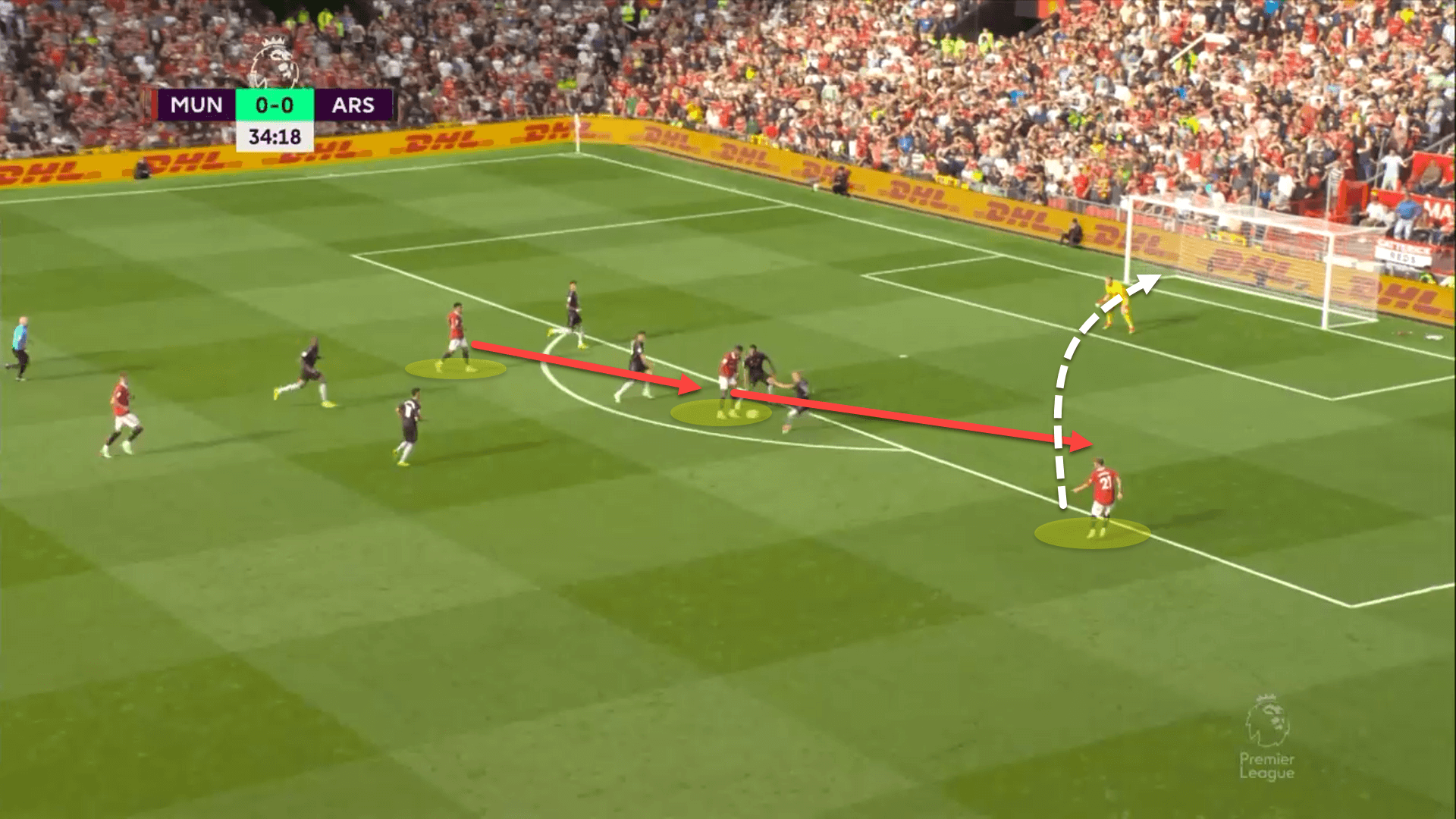
For the rest of the game, ten Hag took a more pragmatic approach than his counterpart. United sat deep, soaking up the Gunners’ pressure and trying to hit them on the break.
However, in the second half, the game plan was faltering, and Arsenal scored to level the match which was now tipping in their favour. However, the home side never wavered.
Just before the hour mark, ten Hag brought Ronaldo on from the bench for Antony with Rashford pushing out to the left, a change that worked wonders. United looked far deadlier in transition and were able to exploit Arsenal’s high line as the Gunners pushed higher and higher, smelling blood, looking for a winner.
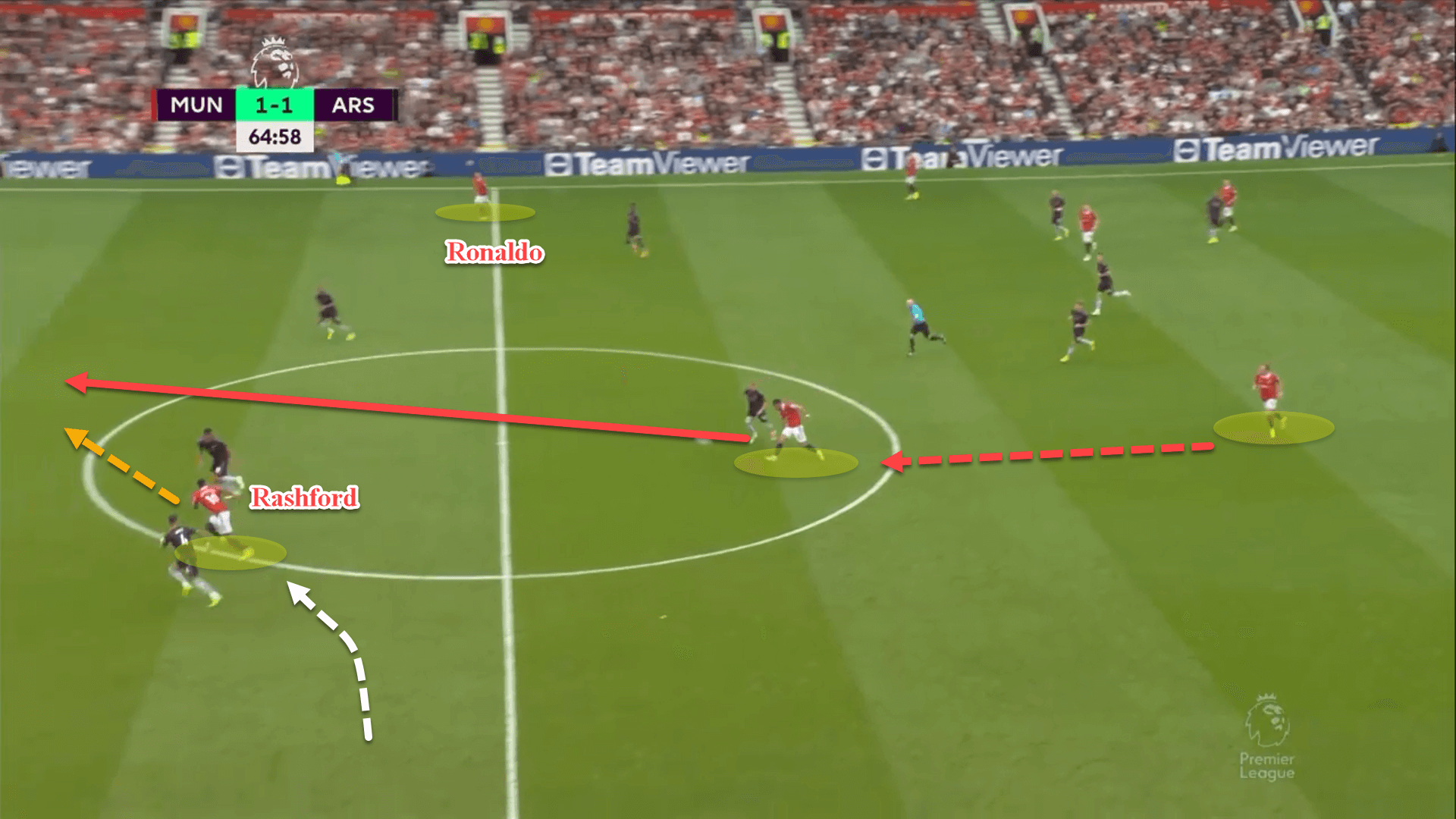
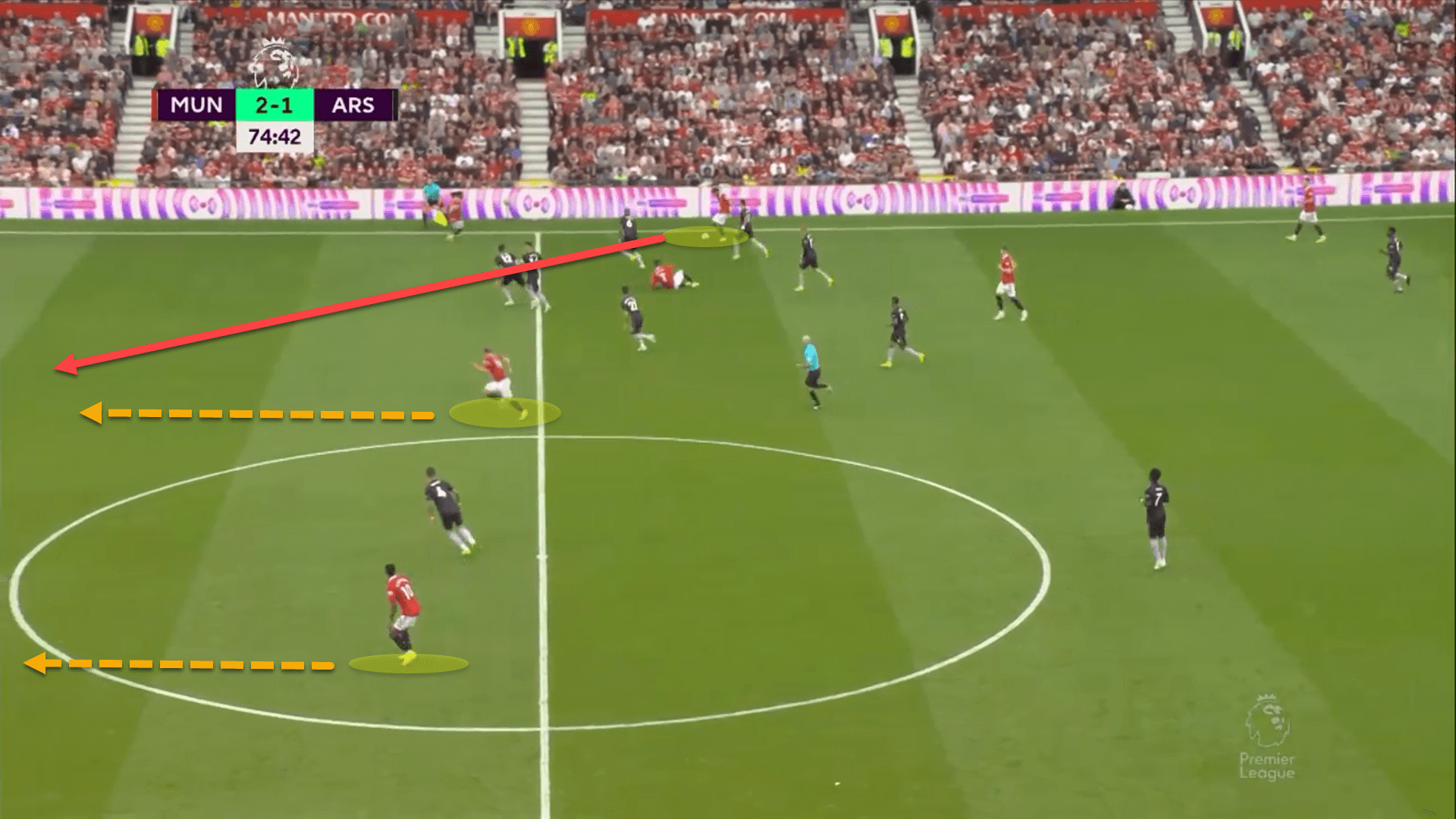
Both of United’s goals, annotated above, came from quick transition-like scenarios, to take advantage of the incredibly high line employed by Arsenal. Rashford’s diagonal runs from out left through the middle were severely difficult for the Gunners to defend against and it ultimately cost them the game.
While ten Hag was praised for his perseverance and use of substitutions, the opposite can be said for Arteta. Arsenal were far too eager to go on and win the match after equalising and it was at a cost to their defensive solidity.
Even after United made it 2-1, the Spanish coach switched to a back three, but with highly attacking players in the midfield and flanks, causing the backline to be exposed time and time again.
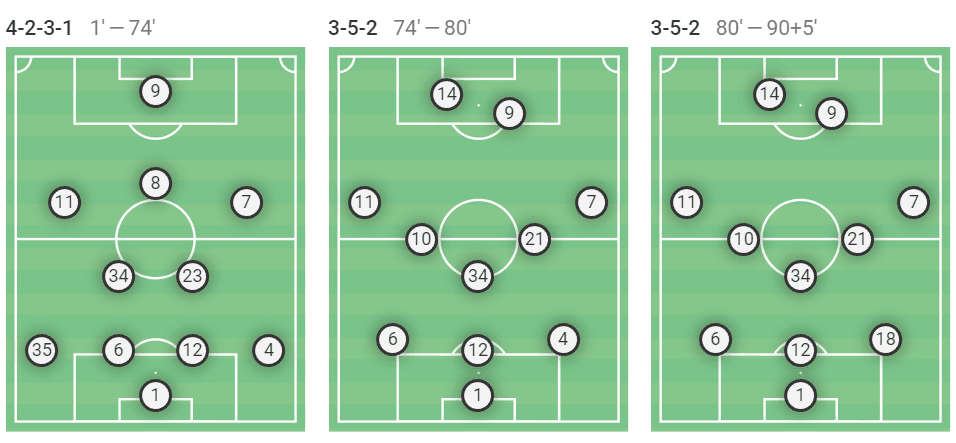
Conclusion
In November 2014, Manchester United faced Arsenal at the Emirates Stadium in the Premier League. A recently appointed Louis van Gaal was trying to impose his possession-based style onto the side but opted to take a more pragmatic approach against Wenger’s FA Cup holders.
United scored early into the second half after an Antonio Valencia strike was deflected past Wojciech Szczęsny off the leg of Kieran Gibbs. With fifteen minutes of normal time left and being just one goal down, Wenger piled men forward in their droves, hoping to secure an equaliser.
Unfortunately, this proved to be naïve from the legendary coach and was poor game management as Man United managed to exploit the lack of defenders at the back to bag a second, securing the three points. Arteta played in midfield for Arsenal in that very same game. History has a funny way of repeating itself.






Comments